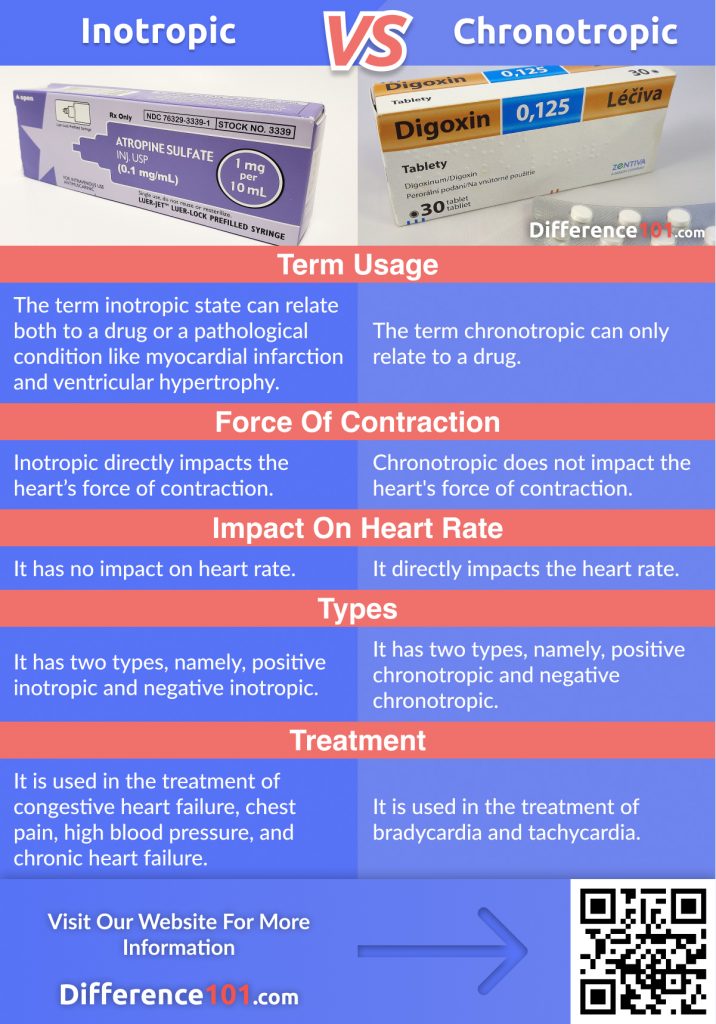The inotropic vs. chronotropic difference lies in the impact of these medicines on our hearts. Inotropic agents or medicines impact the contraction force of cardiac muscles. On the other hand, chronotropic drugs alter the heart rate and rhythm by impacting the heart’s electrical conduction system and the related nerves.
Let’s take a closer look at chronotropic vs. inotropic:
| Contraction force | Inotropic impacts heart’s contraction force while chronotropic doesn’t |
| Heart rate | Chronotropic alters heart rate unlike inotropic |
| Use of term | Inotropic might relate to pathological conditions but chronotropic cannot |
| Interdependence | Many drugs can show both inotropic as well as chronotropic effects |
Table of Contents
What is Inotropic?
Inotropic agents or medicines impact the contraction force of cardiac muscles. Two types of inotropic medicines, positive and negative, are used to improve or weaken the force of cardiac contraction respectively. The term “inotropic state” can also be used for pathological conditions like enlarged heart muscle.
What is Chronotropic?
Chronotropic drugs have the potential to alter the heart rate and rhythm by impacting the heart’s electrical conduction system and the related nerves that influence it. Two types of chronotropic drugs, positive and negative, are used to increase and decrease heart rate respectively.
Inotropic vs. Chronotropic Pros and Cons
Inotropic Pros and Cons
Pros of Inotropic Drugs
- Positive inotropic medicines are used in the treatment of congestive heart failure.
- Negative inotropic medicines are used to treat chest pain, high blood pressure, and chronic heart failure.
Cons of Inotropic Drugs
- These drugs might cause dizziness.
- Some patients might experience loss of appetite.
Chronotropic Pros and Cons
Pros of Chronotropic Drugs
- Positive chronotropic medicines are used in the treatment of bradycardia.
- Negative chronotropic medicines are used to treat tachycardia.
Cons of Chronotropic Drugs
- These drugs might cause nausea.
- Some patients might experience anxiety.
Chronotropic vs. Inotropic Examples
Chronotropic Examples
- Atropine
- Epinephrine
- Milrinone
- Acetylcholine
- Metoprolol
Inotropic Examples
- Digoxin
- Berberine
- Dopexamine
- Insulin
- Glucagon
- Disopyramide
- Voacristine
- Quinidine
Similarities Between Inotropes and Chronotropes Explained
- Both inotrope and chronotrope drugs impact the functioning of our hearts.
- They are used in the treatment of heart-related conditions.
- Both the drugs have two types or subcategories called positive and negative.
5 Key Points of Difference between Inotropic and Chronotropic Drugs That You Must Understand
There are several key differences between inotropic and chronotropic drugs:
| Basis | Inotropic | Chronotropic |
|---|---|---|
| Term usage | The term inotropic state can relate both to a drug or a pathological condition like myocardial infarction and ventricular hypertrophy. | The term chronotropic can only relate to a drug. |
| Force of contraction | Inotropic directly impacts the heart’s force of contraction. | Chronotropic does not impact the heart’s force of contraction. |
| Impact on heart rate | It has no impact on heart rate. | It directly impacts the heart rate. |
| Types | It has two types, namely, positive inotropic and negative inotropic. | It has two types, namely, positive chronotropic and negative chronotropic. |
| Treatment | It is used in the treatment of congestive heart failure, chest pain, high blood pressure, and chronic heart failure. | It is used in the treatment of bradycardia and tachycardia. |
Comparison Chart

Comparison Video
Inotropic and Chronotropic FAQ
Is Digoxin Chronotropic or Inotropic?
Digoxin is both chronotropic and isotropic. It is a negative chronotropic since it decreases the heart rate. At the same time, It is a positive inotropic as it improves the force of cardiac contraction. (Ref. 1)
What is an Inotropic Effect?
An inotropic effect is an impact that an inotropic drug leaves on the heart. A positive inotropic agent strengthens or improves the force of cardiac contraction while a negative inotropic agent weakens the heart’s contraction force.
What is the Most Important Negative Inotropic Agent?
Beta-blockers are the most important negative inotropic agents since a few of them are used in successfully treating congestive heart failure. For instance, carvedilol and metoprolol.
Is Nitroglycerin an Inotropic?
Nitroglycerin is both an inotropic and a chronotropic. It has a positive inotropic effect as well as a positive chronotropic effect. (Ref. 2)
Do Inotropic Drugs Increase Cardiac Output?
Yes, inotropic drugs carry the ability to increase cardiac output. The positive inotropic drugs help in pumping more blood through the circulatory system by improving the force of the heart’s contraction, thereby increasing cardiac output.
What Drug has a Negative Inotropic Effect?
Some drugs having negative inotropic effects are:
- Beta-blockers like carvedilol and metoprolol
- Calcium channel blockers like Verapamil and Diltiazem
- Antiarrhythmics like Quinidine and Disopyramide
Is Amiodarone an Inotropic Drug?
Yes, amiodarone is an inotropic drug. It is a positive inotropic with class III antiarrhythmic action. (Ref. 3)
Is Dopamine an Inotropic Drug?
Yes, dopamine is an inotropic drug leaving a positive inotropic effect on the heart.
Is Digoxin a Positive or Negative Inotrope?
Digoxin is a positive inotropic and is the only safe oral positive inotropic drug that is effective. (Ref. 4)
What is the Goal of Inotrope Therapy?
The goal of inotropic therapy is to deliver oxygen and maintain sufficient tissue perfusion. (Ref. 5)
What are Dromotropic Drugs?
Like inotropic and chronotropic, dromotropic drugs are also used to treat heart-related conditions. The inotropic vs. chronotropic vs. dromotropic difference lies in the impact they leave on the heart. Inotropic drugs impact the contraction force of cardiac muscles, chronotropic drugs impact the heart rate, and dromotropic drugs impact the conduction of electric impulses of the heart.
The Final Words
Though both inotropic and chronotropic drugs are used to treat heart-related conditions, they vary in their functions. Inotropic drugs or agents have a direct impact on the force of cardiac contraction. The positive inotropic drugs improve or strengthen the force of contraction while the negative inotropic drugs weaken it. On the contrary, chronotropic drugs alter the heart rate and rhythm by directly impacting the heart’s electrical conduction system and the nerves that influence it. The positive chronotropic drugs increase the heart rate while negative chronotropic drugs decrease it.
References
- https://go.drugbank.com/drugs/DB00390
- https://pubmed.ncbi.nlm.nih.gov/6791960/
- https://pubmed.ncbi.nlm.nih.gov/2308902/
- https://www.ncbi.nlm.nih.gov/pmc/articles/PMC4898603/#:~:text=Digoxin%2C%20the%20only%20safe%20and,and%20augmenting%20the%20parasympathetic%20tone.
- https://www.ncbi.nlm.nih.gov/pmc/articles/PMC3219255/







